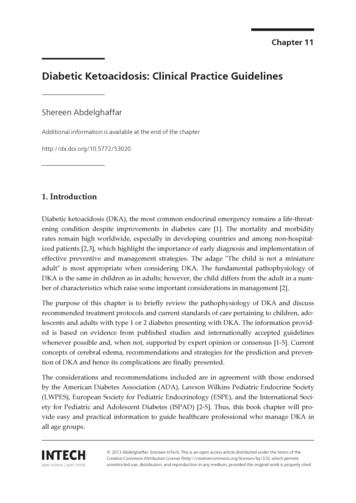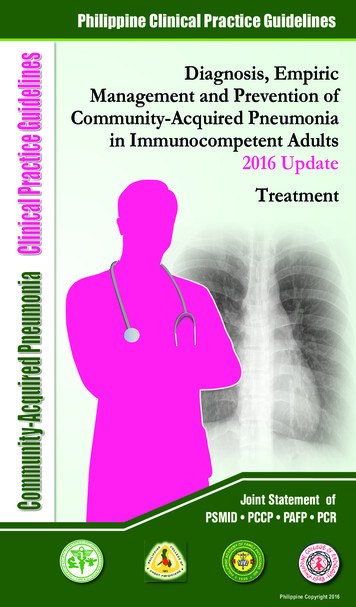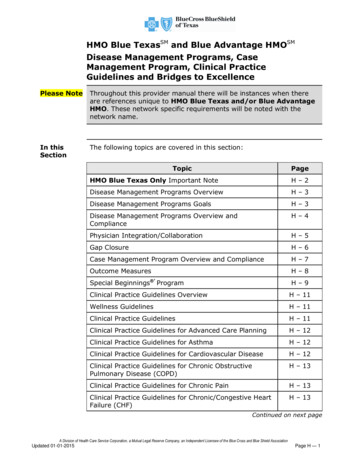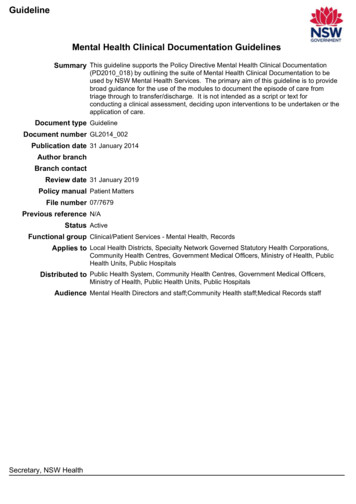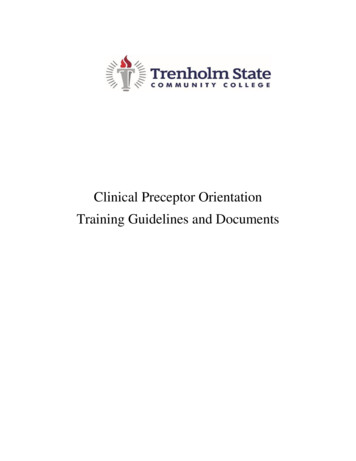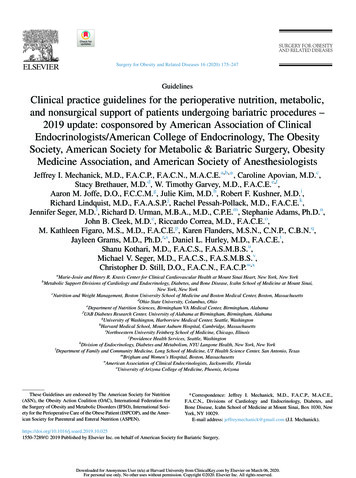
Transcription
Surgery for Obesity and Related Diseases 16 (2020) 175–247GuidelinesClinical practice guidelines for the perioperative nutrition, metabolic,and nonsurgical support of patients undergoing bariatric procedures –2019 update: cosponsored by American Association of ClinicalEndocrinologists/American College of Endocrinology, The ObesitySociety, American Society for Metabolic & Bariatric Surgery, ObesityMedicine Association, and American Society of AnesthesiologistsJeffrey I. Mechanick, M.D., F.A.C.P., F.A.C.N., M.A.C.E.a,b,*, Caroline Apovian, M.D.c,Stacy Brethauer, M.D.d, W. Timothy Garvey, M.D., F.A.C.E.e,f,Aaron M. Joffe, D.O., F.C.C.M.g, Julie Kim, M.D.h, Robert F. Kushner, M.D.i,Richard Lindquist, M.D., F.A.A.S.P.j, Rachel Pessah-Pollack, M.D., F.A.C.E.k,Jennifer Seger, M.D.l, Richard D. Urman, M.B.A., M.D., C.P.E.m, Stephanie Adams, Ph.D.n,John B. Cleek, M.D.e, Riccardo Correa, M.D., F.A.C.E.o,M. Kathleen Figaro, M.S., M.D., F.A.C.E.p, Karen Flanders, M.S.N., C.N.P., C.B.N.q,Jayleen Grams, M.D., Ph.D.r,s, Daniel L. Hurley, M.D., F.A.C.E.t,Shanu Kothari, M.D., F.A.C.S., F.A.S.M.B.S.u,Michael V. Seger, M.D., F.A.C.S., F.A.S.M.B.S.v,Christopher D. Still, D.O., F.A.C.N., F.A.C.P.w,xabMarie-Jos ee and Henry R. Kravis Center for Clinical Cardiovascular Health at Mount Sinai Heart, New York, New YorkMetabolic Support Divisions of Cardiology and Endocrinology, Diabetes, and Bone Disease, Icahn School of Medicine at Mount Sinai,New York, New YorkcNutrition and Weight Management, Boston University School of Medicine and Boston Medical Center, Boston, MassachusettsdOhio State University, Columbus, OhioeDepartment of Nutrition Sciences, Birmingham VA Medical Center, Birmingham, AlabamafUAB Diabetes Research Center, University of Alabama at Birmingham, Birmingham, AlabamagUniversity of Washington, Harborview Medical Center, Seattle, WashingtonhHarvard Medical School, Mount Auburn Hospital, Cambridge, MassachusettsiNorthwestern University Feinberg School of Medicine, Chicago, IllinoisjProvidence Health Services, Seattle, WashingtonkDivision of Endocrinology, Diabetes and Metabolism, NYU Langone Health, New York, New YorklDepartment of Family and Community Medicine, Long School of Medicine, UT Health Science Center, San Antonio, TexasmBrigham and Women’s Hospital, Boston, MassachusettsnAmerican Association of Clinical Endocrinologists, Jacksonville, FloridaoUniversity of Arizona College of Medicine, Phoenix, ArizonaThese Guidelines are endorsed by The American Society for Nutrition(ASN), the Obesity Action Coalition (OAC), International Federation forthe Surgery of Obesity and Metabolic Disorders (IFSO), International Society for the Perioperative Care of the Obese Patient (ISPCOP), and the American Society for Parenteral and Enteral Nutrition (ASPEN).* Correspondence: Jeffrey I. Mechanick, M.D., F.A.C.P., M.A.C.E.,F.A.C.N., Divisions of Cardiology and Endocrinology, Diabetes, andBone Disease, Icahn School of Medicine at Mount Sinai, Box 1030, NewYork, NY 10029.E-mail address: jeffreymechanick@gmail.com (J.I. .0251550-7289/Ó 2019 Published by Elsevier Inc. on behalf of American Society for Bariatric Surgery.Downloaded for Anonymous User (n/a) at Harvard University from ClinicalKey.com by Elsevier on March 06, 2020.For personal use only. No other uses without permission. Copyright 2020. Elsevier Inc. All rights reserved.
176Jeffrey I. Mechanick et al. / Surgery for Obesity and Related Diseases 16 (2020) 175–247pHeartland Endocrine Group, Davenport, IowaMassachusetts General Hospital Weight Center, Boston, MassachusettsrDepartment of Surgery, University of Alabama at Birmingham, Birmingham, AlabamasBirmingham VA Medical Center, Birmingham, AlabamatDivision of Endocrinology, Diabetes, Metabolism, and Nutrition, Mayo Clinic, Rochester, MinnesotauGundersen Health System, La Crosse, WisconsinvBariatric Medical Institute of Texas, San Antonio, Texas, University of Texas Health Science Center, Houston, TexaswCenter for Nutrition and Weight Management Director, Geisinger Obesity Institute, Danville, PennsylvaniaxEmployee Wellness, Geisinger Health System, Danville, PennsylvaniaqAbstractObjective: The development of these updated clinical practice guidelines (CPG) was commissionedby the American Association of Clinical Endocrinologists, The Obesity Society, the American Society of Metabolic and Bariatric Surgery, the Obesity Medicine Association, and the American Societyof Anesthesiologists boards of directors in adherence to the American Association of Clinical Endocrinologists 2017 protocol for standardized production of CPG, algorithms, and checklists.Methods: Each recommendation was evaluated and updated based on new evidence from 2013 to thepresent and subjective factors provided by experts.Results: New or updated topics in this CPG include contextualization in an adiposity-based, chronicdisease complications–centric model, nuance-based, and algorithm/checklist-assisted clinicaldecision-making about procedure selection, novel bariatric procedures, enhanced recovery after bariatric surgery protocols, and logistical concerns (including cost factors) in the current healthcare arena.There are 85 numbered recommendations that have updated supporting evidence, of which 61 arerevised and 12 are new. Noting that there can be multiple recommendation statements within a singlenumbered recommendation, there are 31 (13%) Grade A, 42 (17%) Grade B, 72 (29%) Grade C, and101 (41%) Grade D recommendations. There are 858 citations, of which 81 (9.4%) are evidence level(EL) 1 (highest), 562 (65.5%) are EL 2, 72 (8.4%) are EL 3, and 143 (16.7%) are EL 4 (lowest).Conclusions: Bariatric procedures remain a safe and effective intervention for higher-risk patientswith obesity. Clinical decision–making should be evidence-based within the context of a chronic disease. A team approach to perioperative care is mandatory with special attention to nutritional andmetabolic issues. (Surg Obes Relat Dis 2020;16:175–247.) Ó 2019 Published by Elsevier Inc. onbehalf of American Society for Bariatric Surgery.Key words:Bariatric surgery; Obesity; Guidelines; Metabolic surgery; NutritionLay AbstractObesity is an officially recognized global disease andcontinues to be a risk factor for chronic medical conditionssuch as cardiovascular diseases, diabetes, chronic kidneydisease, nonalcoholic fatty liver disease, metabolic syndrome, and many cancers. This updated guideline is basedon an increased number and quality of the best availablescientific studies to guide physicians in the clinical care ofpatients with obesity who undergo surgical and nonsurgicalbariatric procedures. This guideline identifies patient candidates for bariatric procedures, discusses which types ofbariatric procedures should be offered, outlines management of patients before procedures, and recommends howto optimize patient care during and after procedures. Sincepublication of the previous guideline in 2013, the role ofbariatric surgery in the treatment of patients with type 2diabetes has grown substantially. Studies have demonstratedthat bariatric/metabolic surgery achieves superior improvements in glycemic control of patients with type 2 diabetesand obesity, compared with various medical and lifestyleinterventions, and leads to substantial cost savings.Improved cardiovascular outcomes and quality of life havealso been reported in patients undergoing bariatric surgery.New and emerging surgical and nonsurgical bariatric procedures are described. Criteria for bariatric procedures arebetter defined. This update includes checklists to assisthealthcare professionals achieve greater precision in clinicaldecision-making and discusses the importance of a teamapproach to patient care with special attention on nutrition,metabolism, and interventions to improve recovery afterbariatric surgery. Enhanced recovery after bariatric surgeryprocedures are discussed in detail. Bariatric proceduresremain a safe and effective intervention for higher-risk patients with obesity.IntroductionThis 2019 clinical practice guideline (CPG) update provides revised clinical management recommendations thatincorporate evidence from 2013 to the present, a periodmarked by a significant increase in the total number ofDownloaded for Anonymous User (n/a) at Harvard University from ClinicalKey.com by Elsevier on March 06, 2020.For personal use only. No other uses without permission. Copyright 2020. Elsevier Inc. All rights reserved.
Jeffrey I. Mechanick et al. / Surgery for Obesity and Related Diseases 16 (2020) 175–247177Table 1Increased PubMed citations on bariatric surgery with each clinical practice guidelines update*YearsNon-English (% total)RCT (% D)Meta-analysis (% D)Review (% D)Guideline (% D)Total (% D),20082008–20122013–2018All Years975 (13)576 (8)605 (4)2156 (7)204201 (2.01)746 (271)11542046 (130)218 (374)28411481210 (5)2396 (98)47543440 (18)44 (0.1)11877467254 (26)14,105 (94)29,105RCT 5 randomized controlled trial.Non-English figures were the difference of unfiltered amounts and the “English” language filter. Non-English percentages use “Total”publications as the denominator. Percentage change (% D) uses the figure at the previous publication date range as the denominator. Simpleanalysis shows that the greatest increase in total, RCT, meta-analysis, and reviews occurred since publication of the last American Association of Clinical Endocrinologists/American Society of Metabolic and Bariatric Surgery/The Obesity Society bariatric surgery clinicalpractice guidelines update in 2013 [1]. The number of guidelines and non-English publications on bariatric surgery has remained generallyconstant over the years.* The search term used was “bariatric surgery” on December 31, 2018. Standard PubMed filters were used with customized publicationdatespublications on bariatric surgery, especially randomizedcontrolled trials (RCTs), meta-analyses, and reviews(Table 1). In addition, this update requires reinterpretationof the utility and decision-making process within the contextof an evolving obesity-care model, increasingly detailedmanagement strategies and protocols, and the need for amore transparent tactical plan in a probing and scrutinizinghealthcare environment. New diagnostic terms, structuredlifestyle approaches, pharmaceutical options, and surgicaland nonsurgical procedures have reshaped the obesity-carespace. A general overview of the clinical pathway for bariatric surgery is provided in Fig. 1. Readers are advised to referto earlier editions of this CPG for additional supporting evidence, including the basics of bariatric surgery mechanismsof actions, risks, and benefits.Update on obesity as a disease and clinical assessmentSince the publication of the 2013 American Associationof Clinical Endocrinologists (AACE)/The Obesity SocietyFig. 1. Bariatric procedure decision-making. BMI 5 body mass index.(TOS)/American Society of Metabolic and Bariatric Surgery (ASMBS) bariatric surgery CPG [1], obesity hascontinued to be a major national and global health challenge, as well as a risk factor for an expanding set of chronicdiseases, including cardiovascular disease (CVD), diabetes,chronic kidney disease, nonalcoholic fatty liver disease(NAFLD), metabolic syndrome (MetS), and many cancers,among other co-morbid conditions. Obesity is now includedamong the global noncommunicable disease targets identified by the World Health Organization (WHO) [2–4]. In2015, a total of 107.7 million children and 603.7 millionadults had obesity worldwide [5]. The prevalence of obesityin the United States is among the highest in the world. According to the National Health and Nutrition ExaminationSurvey 2013–2016 data set, 38.9% of U.S. adults and18.5% of youth aged 2 to 19 years had obesity [6,7]. Thistranslates into 93.3 million adults and 13.7 million childrenand youth, respectively. More women (40.8%) than men(36.5%) were obese, with non-Hispanic black women(55.9%) showing the highest prevalence [6,7]. Althoughthe prevalence of obesity has been steady among adultssince 2011 to 2012, prevalence in certain subpopulationscontinue to rise, particularly for those with severe (classIII, body mass index [BMI] 40 kg/m2) obesity, amongwhom overall age-adjusted rates of prevalence are 5.5%and 9.8% for men and women, respectively, and 16.8%for non-Hispanic women [8].The global burden of obesity is driven by the associationbetween BMI and increased morbidity and mortality.Although BMI is simplistic (it is only an anthropometriccalculation of height-for-weight; or more specifically,weight in kilograms divided by height in meters squaredand has been criticized as an insensitive marker of disease,it currently provides the most useful population-level measurement of overweight and obesity, and its utility as an estimate of risk has been validated in multiple large populationstudies across multiple continents. The J-shaped curve forBMI and mortality has recently been confirmed in a largemeta-analysis [9] and a systematic review [10] that includedDownloaded for Anonymous User (n/a) at Harvard University from ClinicalKey.com by Elsevier on March 06, 2020.For personal use only. No other uses without permission. Copyright 2020. Elsevier Inc. All rights reserved.
178Jeffrey I. Mechanick et al. / Surgery for Obesity and Related Diseases 16 (2020) 175–24710.6 million and 30 million participants, respectively. These2 studies confirm that both overweight and obesity increasethe risk of all-cause mortality and should be prioritized on apopulation level.Based on the complexity of body-weight regulation,increased morbidity and mortality associated with obesity,and the substantial burden on public health, obesity was officially recognized as a disease by the American Medical Association in 2013 and multiple other organizations, mostrecently the World Obesity Federation [11]. Several guidelines for treatment of obesity have also been published asa resource for clinicians since 2013. Most notable are theAmerican Heart Association/American College of Cardiology/TOS Guideline for the Management of Overweightand Obesity in Adults [12], the AACE and American College of Endocrinology (ACE) Clinical Practice Guidelinesfor Comprehensive Care of Patients with Obesity [13], theObesity Medicine Association Obesity Management Algorithm [14], and the Pharmacological Management ofObesity guidelines from the Endocrine Society [15]. In2017, the American Gastroenterological Association issueda Practice Guide on Obesity and Weight Management, Education, and Resources that emphasized a comprehensiveapproach to assessment, treatment, and prevention [16].This American Gastroenterological Association guidelineis particularly important for the increasing number of gastroenterologists who are performing endoscopic proceduresfor the treatment of obesity that include placement of intragastric balloons (IGB), plications and suturing of the stomach, and insertion of a duodenal-jejunal bypass liner, amongother emerging procedures [17].In addition to these guidelines, efforts are also underwayto develop more practical and useful assessments to identifypatients who require increased medical attention forobesity-related conditions. Analogous to other staging systems commonly used for congestive heart failure or chronickidney disease, the AACE/ACE obesity CPG proposes anobesity-staging system that is based on ethnic-specificBMI cutoffs along with assessment for adiposity-relatedcomplications [13]. Stage 0 is assigned to individuals whohave overweight or obesity by BMI classification but haveno complications, whereas Stage 1 and 2 are defined as individuals who are overweight or obese by BMI classificationand have 1 mild-to-moderate complications (Stage 1) or atleast 1 severe complication (Stage 2). Building off thiscomplications-centric approach to obesity care, AACE/ACE recently proposed a new diagnostic term for obesityusing the abbreviation “ABCD,” which stands for“adiposity-based chronic disease” [18]. A different functional staging system for obesity was proposed by Sharmaand Kushner [19]. Using a risk-stratification construct,referred to as the “Edmonton Obesity Staging System,” individuals with obesity are classified into 5 graded categories, based on their morbidity and health-risk profilealong 3 domains, including medical, functional, andbehavioral. The staging system was shown to predictincreased mortality in 2 large population cohorts [20,21].The need to shift from BMI- to complications-centric decision-making has applications beyond the United Stateswhere, for example, in China, acceptance levels for bariatricsurgery are principally based on the need for and expectations of weight loss, rather than treatment of severeobesity-related complications (ORC) [22,23].Update on nonsurgical therapiesMany bariatric surgical and nonsurgical procedures arereimbursed by third-party payors, use U.S. Food and DrugAdministration (FDA)-approved devices, or remain available through clinical investigative protocols (Fig. 2). Advancements in nonsurgical approaches to obesity includedevelopment of endoscopic bariatric therapies and approvalof newer antiobesity medications. Various endoscopic bariatric therapies function to reduce gastric volume by 1 ofthe following 3 techniques: (1) reduce the stomach’s capacity via space-occupying devices, such as IGB, (2) remodelthe stomach using endoscopic suturing/plication devices,such as endoscopic sleeve gastroplasty, and (3) divert excesscalories away from the stomach, such as aspiration therapy[17]. Three gastric balloons have been approved by the FDAsince 2015 for patients with a BMI 30 to 40 kg/m2, includingthe ReShape Duo (ReShape Medical, San Clemente, CA,USA), the Orbera intragastric balloon (Apollo EndoSurgery,Austin, TX, USA), and the Obalon Balloon (Obalon Therapeutics, Inc., Carlsbad, CA, USA). Although these endoscopically placed devices are associated with short-term (6mo) weight loss, their utility and safety in long-term obesitymanagement remain uncertain [24]. The other nonsurgicalresources for treatment of obesity are antiobesity medications, which are well defined in guidelines for obesity treatment based on demonstrable weight loss efficacy andassociated metabolic improvements. Four medicationshave been approved by the FDA since 2012, including phentermine/topiramate ER, lorcaserin, naltrexone/bupropionER, and liraglutide 3.0 mg [25]. Antiobesity medicationsare approved by the FDA for patients with a BMI 30 kg/m2 without ORC or 27 kg/m2 when associated with atleast 1 ORC. Based primarily on retrospective data and personal experience, these medications are increasingly used inpatients who have undergone bariatric surgery but haveexperienced either insufficient weight loss or frank weightregain.Update on bariatric surgerySignificant additions to the evidence base have occurredsince the publication of the 2013 TOS/ASMBS/AACE bariatric surgery CPG [1]. A PubMed computerized literaturesearch (performed between January 1, 2013 and December31, 2018) using the search term “bariatric surgery”revealed a total of 14,105 citations. Update of this 2019Downloaded for Anonymous User (n/a) at Harvard University from ClinicalKey.com by Elsevier on March 06, 2020.For personal use only. No other uses without permission. Copyright 2020. Elsevier Inc. All rights reserved.
Jeffrey I. Mechanick et al. / Surgery for Obesity and Related Diseases 16 (2020) 175–247179Fig. 2. Current surgical and endoscopic bariatric procedures. The 4 surgical procedures shown are endorsed by the American Society of Metabolic and BariatricSurgery. Laparoscopic sleeve gastrectomy comprises 70% of currently performed procedures, followed by laparoscopic gastric bypass (25%), adjustable gastricbanding (3%), and duodenal switch (2%). Endoscopic procedures include aspiration therapy (AspireAssist*), space-occupying gastric devices (Ellipse, Obalon,
bariatric surgery. Enhanced recovery after bariatric surgery procedures are discussed in detail. Bariatric procedures remain a safe and effective intervention for higher-risk pa-tients with obesity. Introduction This 2019 clinical practice guideline (CPG) update p
